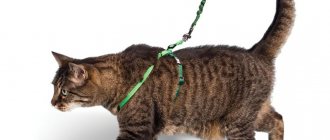Many animal lovers have both cats and dogs. But the first question that worries many people who want to have two different animals at the same time is: how to make friends with each other?
Animal psychologists say that the main mistake of any owner is not to interfere in the relationship of pets in the first days.
Animals are not people, and they cannot resolve conflicts among themselves.
In addition, they speak different “languages”.
Therefore, if you do nothing, the cat will definitely harbor a grudge or be very scared.
It is very important here to adhere to the golden mean: you cannot indulge the animal, but you also cannot use jealousy as a method of education.
The following recommendations and tips will be useful to you:
- encourage good neighborly relationships between dogs and cats;
- do not let the dog very close to the cat, otherwise it will start to hiss and rush;
- If possible, keep the animals in different rooms for the first days, even if the pets do not start fights;
- You cannot feed pets in the same room.
Dachshunds get along very poorly with representatives of the feline species. They take a long time to get used to cats and can injure them in the first weeks of living together.
The most amazing thing is that in the presence of the owner, these dogs behave very friendly, but as soon as you step outside the threshold, at the first opportunity they will grab the cat’s neck. Hunting dogs act this way instinctively.
Animal psychologists recommend arranging the first meeting to get to know each other in 1-2 days, but animals must be kept at a distance of 2-3 meters.
At the same time, pets need to be calmed, for example, by petting them. But first, feel sorry for the animal that was already in the house, and then for the new pet.
After which they need to be treated to something tasty.
Can a cat and a dog be friends?
I can say with confidence that peaceful relationships between animals are indeed possible. Much depends on their temperament and the owner’s ability to teach their pets to behave correctly with each other.
In terms of devotion and level of trust, the cat-dog relationship can become similar to the human concept of friendship. By the way, in dogs, loyalty to the owner and other individuals is much higher, while cats are driven by more selfish motives. One study found that during contact with living beings, dogs release more happy hormones than cats.
I have read articles by animal psychologists who explain that attachment begins with the desire for animals to be nearby and to use the skills of another to their advantage. For example, a cat can throw food off the table for a dog, and the dog will act as a protector on the street. But not all pets are ready for peaceful coexistence.
It is easiest to make friends with puppies and kittens, because they will grow up together, and the owners will have enough time to instill communication skills. The optimal age for kittens is up to 6 months, for puppies – up to 1 year. Interesting statistics: if a dog is adopted as a second pet, its attitude towards the cat becomes friendly in 75% of cases, and the order of adoption has almost no effect on the cat.
Introducing a cat to a puppy is relatively easy, especially if you have a female. Sometimes they mistake puppies for their children and are especially patient with the baby’s games. It is more difficult to introduce adults to already established behavior.
An adult purr and a small puppy
Of course, it is better for animals to live together since childhood, but if this did not work out, then do not be upset.
If you already have a cat in your home, get a puppy between three and twelve weeks of age. This way they can get along quite easily, especially if you don’t allow them to come into close contact at first. It’s just that a little puppy is always friendly, but if he wants to play with a cat, he can meet with resistance. It's better to introduce them at a distance first
It is necessary to pay attention to the purr so that it does not seem that it is now an unloved animal
As a rule, puppies do not show aggression towards cats due to their friendliness and age. Very often, adult purrs take custody of doggies. Sometimes they remain indifferent. In any case, existence should be peaceful.
During the introduction, keep an eye on the cat. If she bites the puppy’s tail, lies on top or in his place, then she is friendly towards the baby. If a small dog wags its tail and takes characteristic poses for playing, then it also expresses sympathy for the purr.
Why are animals not friends?
Before we strive to make friends with pets, we must recognize that not everything depends on the owner, and some animals will not live in peace and tranquility, no matter how much we want it.
Let's be honest: not all cats are sociable and react calmly to strangers and other pets. If a stranger appears in the house, the cat hides or defends itself.
Some dogs are poorly socialized and unfamiliar with cats. They may meet cats on the street while walking and try to play with them, but such a reaction is unlikely to meet with the approval of the pet.
Cats that grew up alone and are used to being dominant in the home may attack a small puppy.
Be prepared for this scenario and take care that the dog and cat are not harmed during communication.
How to choose the right breed
If you want to add a new member to your family, it is useful to learn more about the characteristics of purebred animals and their ability to get along with other individuals.
Dogs of hunting breeds do not favor small animals and often show aggression towards cats. Fox Terrier, Beagle, Russian Hound, Jack Russell Terrier love to hunt “game”. It is best to take them as puppies and raise them in the presence of an adult cat.
A British cat can be absolutely indifferent to a new resident, but sometimes behaves aggressively if the boundaries of its territory are violated. Be prepared for the fact that Persians, despite seeming calm, can scratch a dog’s delicate nose with their claws.
When choosing an animal from a breeder, ask about the pet’s character and how well it gets along with other animals. Usually breeders are attached to their babies and care about their safety, so they won’t cheat.
Outbred animals, especially those taken from the street, are calmer in relation to other individuals, but the acquaintance and life of animals together will improve more quickly if the owners take care of this, rather than leaving everything to chance.
Fight for territory
Even in an incredibly large territory inhabited by two different animals, wars for territory take place, since one individual can oppress the other.
Cats especially show themselves in this regard:
- They value their personal space very much, and in the wild they always set boundaries by marking.
- An overly sociable dog can simply cross the outlined boundaries, which will provoke aggression from the cat.
- Therefore, when the question arises of how to make friends with an adult dog and cats, you need to focus on separating personal spaces.
Animal Meeting
Moving to another place of residence is stressful for any living creature. Before introducing the new arrival to the other residents of the house, give him time to get comfortable. To do this, free up as much space as possible where he will not meet other animals, and give him the opportunity to calm down. The animal may hide, not make contact, and even refuse food. Sometimes this behavior lasts for several days. When you see that the new resident of the house has already settled down, start getting acquainted with other family members.
Offer to sniff the other animal's toys or things. The reaction may vary: if the dog reacts aggressively to the smell of the cat, you should be careful when introducing them.
The meeting of animals should take place in a limited space, for example, a closed room. Remove all glass objects and make sure there are no extraneous loud sounds. Place the cat in a closed carrier and keep the dog on a leash. Animals must see each other, but the distance between them must be decent. Enlist the help of one more person.
Before introducing yourself, take your dog for an active, long walk - this will use up his strength and reduce his activity.
Take turns feeding your dog and cat with one hand. It is important that animals see each other! For them, this will mean that they are not deprived of food in the presence of another animal, which means that nothing threatens their safety and survival. During this time, you can pet your pets and also talk to them affectionately.
It will be useful to meet in the presence of a dog handler, who will adjust the situation and help carry out the procedure competently.
After this, try letting the cat out of the carrier while continuing to keep the dog on a leash. The cat can stay in your arms for a while: pet it, and let your assistant pet the dog. Release the cat on the floor - it will probably want to walk around and sniff its future neighbor.
If the dog jerks towards the cat, restrain it in the manner that is customary for you. The command “fu” works best.
The relaxed state of the dog and cat, both physical and emotional, will indicate that the acquaintance was successful.
Don't be upset if the first attempt was a failure and your pets got nervous. This is fine! Repeat the procedure periodically until you see a weakening of the nervous reaction.
If your cat is too scared, read my article on how to calm your cat.
Cohabitation
When a cat and a dog are relaxed in each other's presence, we can assume that the acquaintance was successful. After this, try taking the leash off the dog and letting the pets go for walks together.
Even if the first stage is completed, you should not forget about safety measures and rules of living together. Aggression sometimes manifests itself unexpectedly from any side. The reason may be the problem of dividing territory, food, security, or fear of pain. Animals sense when they are being “bowed in” and will continue to behave inappropriately if action is not taken.
Nutrition
Most conflicts between pets arise due to food aggression. They actively defend their right to food and will seek primacy in this matter. I was able to eliminate this type of aggression by separating feeding areas.
You can feed animals in the same room, but in different areas. This way they will see that none of them is deprived of the owner’s care. Each pet should have its own bowl for food and water. It is best to feed at a certain time and remove the bowls after that so that the dog does not decide to eat his neighbor's food.
Rest
The struggle for territory is in second place on the list of conflicts. The struggle for a place near the owner can be especially fierce. Some pets love to take over their neighbor's bed, and this is not a problem if the animals get along well together. But more often the owner’s intervention is required, especially at first.
The pet cannot be the leader in the house; the owner always remains in charge. And if he stops territorial encroachments, then the animals will feel safe.
I recommend that you consider having your cat live at a higher elevation. Check out my article on how to make your own cat house. This is not difficult and will definitely not attract the dog, so the issue of territorial conflicts will be minimized.
Entertainment and communication
The dog receives more attention from the owner because it requires more care. A cat may feel a lack of affection, attention and entertainment, especially if there is another pet in the house.
A good way to make friends between a cat and a dog is to involve them in joint games where you will be in charge and can set the rules. Animals will see that they are treated equally, but no one should be offended.
When you have absolutely no energy to be active with your pets, try not to drive them away from you during passive rest. Proximity to the owner is very important for our four-legged friends, and if one does not receive enough attention, then conflicts on this basis are inevitable.
How to litter train a small kitten
Most often, babies learn on their own when they repeat after their mother. But if for some reason this is not possible, you will have to solve the problem yourself!
Watch your diet
On average, a kitten wants to go to the toilet about half an hour after a hearty dinner. Or after prolonged active games and running. If you stick to the regime, in just a couple of days you will be able to accurately predict the time.
Show the tray
The kitten needs to get comfortable, look around and sniff. Bring him to the tray periodically and don’t disturb him if he wants to play, dig around, or just lie there. Take him there after sleeping, playing and eating, and if you see that he has already begun to settle down in another place.
Teach you to dig
If a kitten sees a tray with filler for the first time, he simply does not understand what they want from him. Gently show with your finger that you can dig there, but don’t pull the animal’s paws - it will only get scared!
Special means
Now there are all kinds of sprays and other special products with different scents. Some of them attract cats - and they can be used to treat the litter box. Others, on the contrary, scare away, so they are suitable for treating places where the animal has already managed to go before.
Clean up the mistakes
If the kitten has already done its business in the wrong place, the smell needs to be removed. Special detergents, citrus essential oils and other strong odors are suitable. It’s better to carefully collect the pile with a spatula and transfer it to the tray so that the kitten can see and remember.
Use tricks
If the kitten has already chosen an undesirable place, there is no way to move the tray there, and endless washing does not help, then temporarily move the bowls with food and water there. Clean cats do not go to the toilet where they eat and drink!
Don't scold
There is no need to scold the animal, poke its nose somewhere, or even beat it - this is completely ineffective! The kitten will only begin to be afraid, and maybe take revenge, or learn to hide even better. Talk calmly and praise your pet when he has done everything right.
When to take action
Friends, let's be realistic: sometimes peaceful coexistence between pets is impossible. If a dog regularly tries to attack a cat, and the cat constantly scratches the dog, it is worth taking action.
For dogs, the owner is the authority, and a good way to keep him in line is to remind him of the rules of behavior. Training will help with this. If you have already completed it, it is worth repeating or teaching new commands so that the authority of the owner prevails over instincts. But you need to be extremely careful and understand that at some point you will not be around and the animal may react to the cat.
When you leave home, be sure to place your pets in different rooms or place the dog in an enclosure.
Rules for keeping in one room
The first and main law of such a community is the equal distribution of love and attention to both pets, so that thoughts of jealousy do not arise. In addition, each of them must have their own place for rest and food. Pets must understand that there is only one leader, and that is the owner. There are examples when people allowed one to punish the other, and the hostility between them did not stop. There must be one punishing hand.
In this case, it is important to understand that physical punishment must be avoided: the animal will remember the pain from the punishment and will associate it with its neighbor, directing all the anger and resentment towards him.
Prohibited actions
Friends, there are rules that are very important for animals living together. Remember them and teach them to your children.
- Never pit your pets against each other.
- Don't encourage aggressive behavior.
- Do not practice commands on another pet.
Failure to follow these rules will lead to uncontrollable behavior of the cat and dog, for which you will be to blame.
An equally important aspect: if the animal is sick, be sure to isolate it from other pets. Unfortunately, instincts can play a cruel joke, and the dog will perceive a weakened neighbor as a victim.
Puppy and kitten
Cubs weaned from their mother instinctively seek closeness and attention. Differences between species do not matter to them. The main thing is to have someone to play with. Friendly pranks gradually lead to strong friendship.
But, in such a situation, size matters a lot. A large breed puppy grows quickly and does not know how to dose strength. Hitting a kitten with a large paw can cause injury.
Conversely, a Maine Coon cub may seem like a giant to a Chihuahua puppy and cause fear.
In our entrance, on the third floor, there lived a small French lap dog. When she went for a walk and saw our Siberian cat Vasily on the first floor, she refused to come down. The owner had to carry her in her arms.











